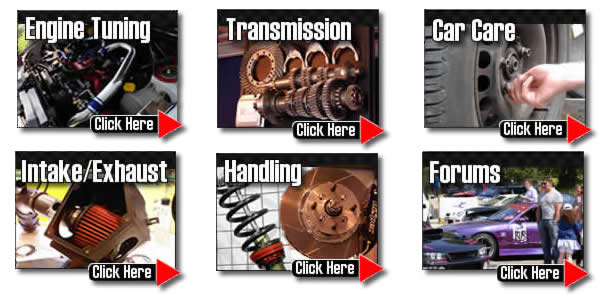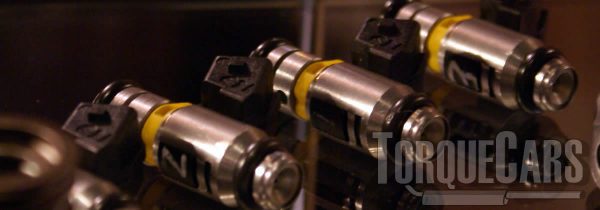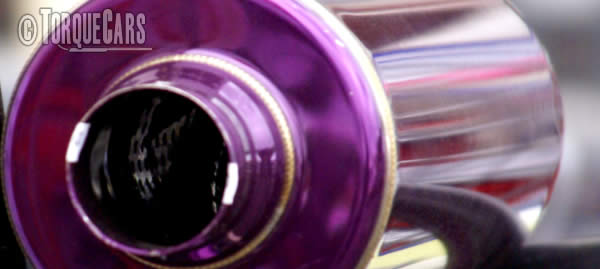Tuning the Alfa Romeo 164
"Thank you for reading my Alfa Romeo 164 tuning guide."
The 164 is a great car modification project to try. The key to 164 tuning is choosing the right mods - a lot of money can be wasted if you do it wrong.
Designed by Pininfarina the Alfa had to fill the shoes of the 90 and Alfa 6. It was made between 1987 and 1998.

Handling/Suspension upgrades
Handling modifications are often a priority for the 164.
We found that most 164 factory suspension setups need tweaking, a few degrees of toe (set some toe out to improve cornering or use toe in for better stability) and you only need around 0.9 to 1.5 degrees, and a little negative camber will usually enhance your cornering and handling.
We would go to a maximum drop of 23mm - 37 mm. on most models. You risk compromising your handling if you go lower than this.
Fitting larger brake discs and better quality pads should make for sharper improved stopping.
As a word of warning please note that race friction pads can grind and will need to be hot before they are effective.
On your regular commute to work the brakes are only used rarely, therefore will not stop you as well so choose pads which have a low working temperature.
A nice wide torque band and sweet spot of peak power at one third of your RPM range is optimum.
Sadly with smaller engine sizes you are wasting your time spending money on modifications, so if this applies to you get yourself an engine swap then apply the following mods.
Power mods.
This list of the stages and sports parts are usually fitted by our members, decide how far you wish to go in your tuning project before you get started.
Getting the right modified upgrade kits for your planned usage of the car is essential. Stage 3 motor sport mods just don't work well on the road and will make the car undrivable.
Please watch our introduction Video tutorial to car tuning. Be sure to subscribe and support our new channel.
How to tune your car
- Improve the handling
Focus on Suspension improvements, such as coilovers and make sure the bushings are in good order and that the alignment is correct. Then focus on improving the brakes, with a big disk brake conversion kit and fast road brake pads.
- Remove restrictions
Focus on the intake and exhaust with filters being the common point of restriction in a tuned car. Intercoolers may also become restrictive on turbo engines so this may also need to be uprated.
- Burn more fuel & air
Increase the fuelling so it matches the air coming into the engine. The ratio is important so you need to improve the fuel pump and injectors, so the head mods, big valve conversions, fast road camshafts and forced induction upgrades extra supply of air is adequately met.
- Test and replace any weak parts
Weak areas are commonly the clutch, the turbocharger and pistons and crankshaft in a highly tuned engine. Makes sure these components will cope with your power aspirations.
- The Tune or Remap
A cars ECU controls the fuel, timing, spark and even the turbo in some cases, so to fully extract your gains you should remap the car last and this will fully release the power. Some cars are easy to map, and others require piggyback ECU's or aftermarket ECU's but this is the most vital step of your tuning project.
Modifying to Stage 1:
Lighter flywheel, Alloy wheels, Suspension upgrade (drop 23mm - 37 mm.), Remap, Sports exhaust, Panel air filter.
Modifying to Stage 2:
Fast road cam, fuel pump upgrades, Ported and polished head, high flow fuel injector, Power/Sport clutch.
Modifying to Stage 3:
Competition cam, Engine balancing, Adding or upgrading forced induction (turbo/supercharger), Internal engine upgrades (pistons/head/valves), Sports gearbox.
Your targets when tuning the engine should be a nice flat torque band. You don't want all the power to be at the top end unless you are creating a motor sport car.
In this article we shall give a limited introduction to the best performance parts for your car, but we'd encourage you to spend some time on the site looking into the details of each type of performance part.A fast road camshaft usually proves to be one of the best NASP power modifications you can do mechanically to your engine.
The intake and exhaust valve timings play a big role in your cars power band, but be careful here, getting this wrong can upset the idle and make the car impossible to drive in traffic. You'd need to follow a cam upgrade with other mods and finish with a remap to fully release the power gain.
When pushing up the power you will need to ramp up to the fuelling. More power needs more fuel.
Most power losses, flat spots and erratic idling after parts are done can usually be traced to timing or fuelling issues.  To get sufficient fuel you may need to upgrade the injectors on your engine.
To get sufficient fuel you may need to upgrade the injectors on your engine.
A fuel pump will only deliver a finite amount of fuel, so you may need to uprate this if your injectors are demanding more fuel.
Intake and Exhaust Tuning.
The next area for modification is the intake and exhaust.  Induction kits only help to add performance if your air intake is struggling! Adding an induction kit to most small engines will see LITTLE LOW END POWER GAIN AT ALL. If you have heavily modified your engine and it's need for air INCREASES DRAMATICALLY then an induction kit is the answer and will help remove this restriction.
Induction kits only help to add performance if your air intake is struggling! Adding an induction kit to most small engines will see LITTLE LOW END POWER GAIN AT ALL. If you have heavily modified your engine and it's need for air INCREASES DRAMATICALLY then an induction kit is the answer and will help remove this restriction.

Maximum power gains come from a full induction kit with a cold air feed on heavily tuned engines, this can be sited within an air box but a performance panel filter should suffice for most applications. TorqueCars suggest you use a panel air filter as these are easy to clean and maintain and generally perform better than paper ones.
Sports exhausts balance the flow of air through the engine. But if your exhaust is too big, ie: over 2.5 inches bore, you will lose a lot of the flow rate and end up sapping power and torque.
Getting a professionally gas flowed head with larger valves can fully release the engines power. A good multi plate fast road uprated clutch will help to keep that power going where it should. Never cut corners or think that the standard OEM clutch to cope. The best mods we would do for your 164 are remaps, sports camshafts and induction improvements.
Remaps offer impressive power gains on all turbo charged cars. On NASP engines the benefits are doubtful. However a remapped ECU on a NASP engine will help unleash the potential if you have done a lot of mods. Despite the large cost involved adding forced induction to a NASP engine will give large power gains. Superchargers are often easier to add than a turbo. Turbos give boost in increasing proportion to rising engine speed and this can make mapping difficult.
The nice correlating boost and rpm characteristics of the supercharger make them easier to map. Decreasing the engines compression ratio will allow you to add forced induction, water injection may also help prevent detonation.
Alloy wheel upgrades.
As alloys are less heavy they improve performance and they help to cool the brake disks. We can't go into too much detail here about tires but they are how the car puts the power down on the road so are a critical choice. directional tread pattern tires work well on 164, and make a big difference over budget tires. We should point out that although they can look cool on the 164 big alloy wheels will actually decrease your performance. The larger you go the lower your acceleration will be - this to the change in your effective final drive ratio.
Because of this we would advise sticking to a maximum wheel size of 16 inches, although we know some of our members have gone larger than this with no problems.
For more information on Tuning your car please join us in our friendly forum where you can discuss 164 options in more detail with our 164 owners. It would also be worth reading our unbiased Alfa Romeo tuning articles to get a full grasp of the benefits and drawbacks of each modification.
Please help us improve these tips by sending us your feedback in the comments box below.
We love to hear what our visitors have got up to and which mods work best for them on each model of car. Comments are used to improve the accuracy of these articles which are continually updated.
If you liked this page please share it with your friends, drop a link to it in your favourite forum or use the bookmarking options to save it to your social media profile.
Check out TorqueCars new YouTube channel, and see their awesome new content...
Feedback
Please use our forums if you wish to ask a tuning question, and please note we do not sell parts or services, we are just an online magazine.
Help us improve, leave a suggestion or tip
